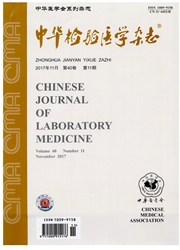

 中文摘要:
中文摘要:
目的比较5种自动化免疫学方法测定25羟维生素D(250HD)和液相色谱串联质谱法(LC-MS/MS)测定250HD方法的一致性。方法本研究属于方法学比对。2014年5月至7月选择245份临床血清样本(总250HD浓度范围:2.8ng/ml-64.0ng/ml,其中154份不含250HD2,91份含有不同浓度的250HD2),应用雅培、索林、IDS、罗氏、西门子五个厂家(文中依次以A,B,C,D,E代表)的自动化免疫学方法和本实验室建立的LC-MS/MS方法共同测定,以LC—MS/MS方法作为参照标准,比较测定结果的一致性,并以250HD〈20ng/ml、20—30ng/ml、〉30ng/ml为临床判定维生素D缺乏、不足和充足的标准,判定各种方法的符合率。测定临床样本之前对各方法进行精密度评价。用MedCalc软件统计处理数据,采用Bland—Ahaman图比较2种方法的差异,以Passing&Bablok回归分析2种方法之间的相关性。结果6种方法测定245例样本的中位数(2.5%-97.5%范围)分别为:23.5(5.8—4J4.2)ng/ml(LC-MS/MS),20.6(7.1~43.5)ng/ml(A),19.0(5.4—38.0)ng/ml(B),23.0(10.0~38.1)ng/ml(C),20.1(5.1~46.0)ng/ml(D),31.3(12.3—71.1)ng/ml(E),Passing&Bablok回归分析显示B方法与LC-MS/MS相关性最好(r=0.894),而A、C和D方法与LC—MS/MS平均偏差相对较小,E方法与LC-MS/MS平均偏差最大。在不含250HD2的样本中,5种自动化免疫学方法得出的结果与LC-MS/MS方法得出的结果的相关性均在0.84以上,相关性最好的为B(r=0.930),但当样本中含有250HD2时,各种方法与LC—MS/MS的相关性均下降。以统一的临床判定阈值,与LC—MS/MS得到的临床判定结果相比,A、B、C、D和E的一致率分别为68.6%、64.9%、67.8%、70.6%和51.8%。结论不同检测系统检测结果相差较大,250HD2对各种免疫学方?
 英文摘要:
英文摘要:
Objective To compare the concordance of five automated 25OHD immunoassays with liquid chromatography tandem mass spectrometry method (LC -MS/MS). Methods During May to July in 2014, 245 clinical serum samples that requested 25OHD tests were selected, with a total 25OHD range of 2.8 ng/ml - 64.0 ng/ml, in which 154 samples did not contain 25OHD2 and 91 samples contains both 25OHD2 and 25OHD3. To used a LC - MS/MS method that built in our laboratory to measure 25OHD, five commercial automated chemiluminescent immunoassays from Abbott Diagnostics (A), DiaSorin LIASON ( B), IDS-iSYS ( C ), Roche Diagnostics ( D ), and Siemens ADVIA Centaur ( E ). Taking the reference method LC-MS/MS as a standard, to compared the concordance and performance of the five automated 25OHD immunoassays. And used the commonly accepted cutoffs for 25OHDdefieieney ( 〈 20 ng/ml) , and insufficiency (20 - 30 ng/ml), and sufficiency ( ≥ 30 ng/ml ) to compare the uniformity of differentmethods. Statistical analysiswere performed by MedCalc software, Passing & Bablok regression, Bland & Ahaman plots and Box and whisker plots were performed to compare the differences of the methods. Results The medium (range:2.5% -97.5% ) 25OHD of the 245 serum samples of the six methods was 23.5 (5.8-44.2) ng/ml(LC-MS/MS),20.6 (7.1-43.5)ng/ml(A) ,19.0 (5.4-38.0) ng/mL (B),23.0 (10.0-38. 1) ng/ml(C),20. 1 (5. 1-46.0) ng/ml (D),31.3 (12.3-71. 1) ng/ml (E), respectively. Passing and Bablok regression showed that method B had the best correlation coefficient with LC-MS/MS (r = 0. 894), while methods A, C and D had relatively small bias compared withLC-MS/MS and method E had the large bias. If the serum samples did not contain 25OHD2, all the five automated immunoassays correlated well with LC-MS/MS with a correlation coefficient higher than 0.84, and B has the best correlation with LC-MS/MS ( r = 0. 930). While all the correlation coefficient between immunoassays
 同期刊论文项目
同期刊论文项目
 同项目期刊论文
同项目期刊论文
 期刊信息
期刊信息
